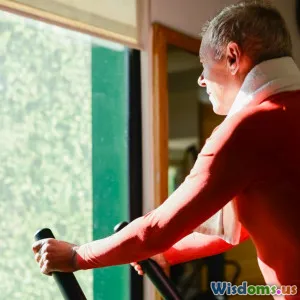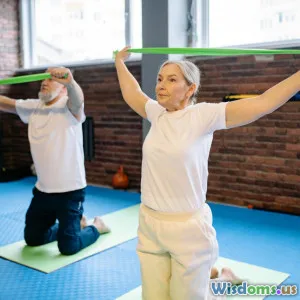
From Walks to Workouts Building Cardiovascular Endurance After 60
8 min read Discover effective strategies to build cardiovascular endurance after 60, transforming simple walks into energizing workouts for lasting heart health and vitality. (0 Reviews)
From Walks to Workouts: Building Cardiovascular Endurance After 60
Aging gracefully takes more than resolving to 'just be healthier.' Cardiovascular endurance, which is the ability of your heart and lungs to supply oxygen during prolonged activity, becomes especially critical after 60. But many wonder: is it too late to improve? The answer is a resounding no. Whether you're a casual stroller or someone looking to enhance your stamina, there's a path forward from gentle walks to vigorous workouts.
This article dives deeply into the science, strategies, and motivating examples of building cardiovascular endurance beyond 60 — empowering you to embrace heart health, boost longevity, and enrich your quality of life.
Understanding Cardiovascular Endurance and Aging
What Is Cardiovascular Endurance?
Cardiovascular endurance, often synonymously called aerobic fitness, reflects how well your heart, lungs, veins, and arteries can deliver oxygen-rich blood to your muscles during exercise. It underpins stamina and directly affects daily activities, from climbing stairs to playing with grandchildren.
Why Focus on It After 60?
After age 60, cardiovascular fitness naturally declines at about 1% per year, influenced by reduced physical activity, changes in heart muscle, and vessel elasticity. According to the American Heart Association, cardiovascular diseases remain the leading cause of death globally, making improved endurance essential for prevention.
However, the body remains remarkably adaptable. Studies published in the Journal of Aging and Physical Activity show that improved cardiovascular conditioning can increase oxygen uptake capacity even in septuagenarians, improving vitality and reducing disease risk.
Starting With Walks: The Foundation of Endurance
The Power of Walking
For many seniors, walking is an accessible and enjoyable entry point. It requires no special equipment, can be done indoors or outdoors, and carries a low injury risk.
The CDC reports that walking regularly improves cardiovascular endurance by stimulating heart rate and lung function over time. Even brisk walks lasting 30 minutes most days can lower blood pressure, reduce cholesterol, and help maintain a healthy weight.
Crafting Effective Walking Routines
- Frequency and Duration: Start with 10-15 minute walks, gradually increasing to 30-45 minutes.
- Pace Matters: Brisk walking (about 3-4 mph) challenges your cardiovascular system versus casual strolling.
- Intervals: Introduce short bursts of faster walking or slight inclines to boost intensity.
For example, Jo Ann, a 65-year-old retiree, began with 10-minute flat walks and over six months progressed to 40-minute neighborhood walks incorporating hills and short power strides, experiencing improved stamina and joy.
Safety Considerations
Slowly build up and watch for unusual symptoms like chest pain, dizziness, or extreme shortness of breath. Consult with a healthcare professional before starting if you have existing heart conditions or other chronic diseases.
Progressing to Workouts: Structured and Varied Approaches
Incorporating Aerobic Exercises
After establishing a walking base, diversifying aerobic activities helps prevent plateaus and enhance overall cardiovascular benefits.
-
Cycling: Stationary or outdoor cycling reduces joint impact while building endurance. Research from Sports Medicine finds cycling accessible for older adults with beneficial aerobic adaptations.
-
Swimming: The buoyancy reduces strain on joints, while continuous movement drives heart and lung health.
-
Dancing: Styles like ballroom or line dancing combine aerobic activity with coordination, cognition, and social engagement, all linked to longevity.
High-Intensity Interval Training (HIIT) for Seniors
Emerging evidence indicates modified HIIT can be safe and effective for improving cardiovascular endurance after 60. For example, research from the European Journal of Applied Physiology showed seniors performing intervals of moderate work (~70% max effort) alternated with recovery had significant VO2 max improvements.
Practical HIIT example:
- Warm-up: 5 minutes slow walking or cycling
- Interval: 1 minute brisk walking or cycling at challenging pace
- Recovery: 2 minutes easy pace
- Repeat 5-7 cycles
Always start with fewer cycles and moderate intensity, gradually increasing.
Resistance Training's Role
While primarily aimed at strength, resistance training indirectly supports endurance by improving muscle efficiency and metabolism. Combining weight training 2-3 times weekly with aerobic workouts can yield holistic cardiovascular health benefits.
Nutrition and Lifestyle: Supporting Cardiovascular Gains
Heart-Healthy Eating
Fueling endurance requires balanced nutrition:
- Emphasize vegetables, fruits, whole grains, and lean proteins.
- Limit saturated fats, trans fats, and added sugars.
- Consider omega-3 fatty acids (found in fish and flaxseed) which protect heart health.
According to the American Dietetic Association, proper nutrition also reduces inflammation, a key marker in cardiovascular disease.
Rest and Recovery
Recovery is crucial, especially as the body ages. Adequate sleep (7-9 hours) and rest days allow heart and muscles to repair and grow stronger.
Monitor Progress with Technology
Simple devices like pedometers, heart rate monitors, or smartwatches can guide intensity and motivation. Aiming for a target heart rate zone during exercise optimizes endurance gains safely.
Real-Life Transformations: Inspiration From the Field
Case Study: George, Age 72
George was sedentary with minor heart concerns. After starting with 15-minute daily walks, he incorporated cycling and HIIT after three months. Ten months later, his cardiologist noted improved blood pressure and aerobic capacity, and George competes now in community cycling events.
Community Initiatives
Programs like SilverSneakers and local senior fitness classes incorporate cardiovascular workouts tailored for older adults, balancing encouragement with safety.
Conclusion: Your Heart, Your Journey After 60
Building cardiovascular endurance after 60 is not merely a health goal — it’s a gateway to independence, joy, and a lively future. Starting with simple walks and progressing to structured workouts illustrates how achievable improved endurance is, regardless of age.
With consistent effort, mindful nutrition, and smart monitoring, you can defy aging stereotypes. As Dr. Michael Joyner, a leading physiologist, puts it, "Age is not the barrier; inactivity is."
Embrace movement today – your heart will thank you for decades to come.
References and further reading available upon request.
Rate the Post
User Reviews
Popular Posts


















